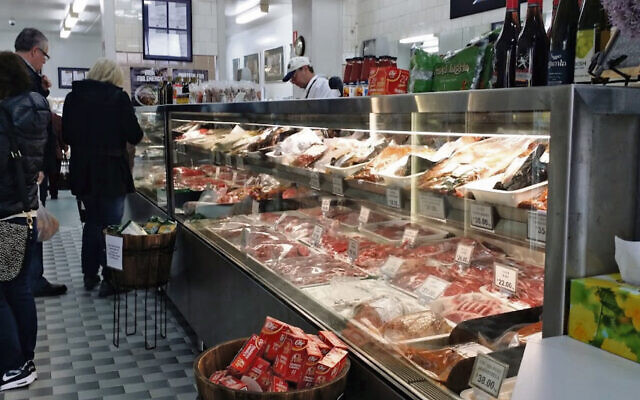The great flood and our diet
It seems clear from the first two parashiyot of Bereshit that God’s original design at the time of creation was that man should be vegetarian.
BERESHIT 1:29-30 refers to herbs and fruit of trees given to man to eat; Bereshit 9:3 tells of the post-flood permission to eat living creatures. The latter permission was, however, subject to strictures. Mankind was forbidden “ever min hachai – a limb of living creature”, while Jews are limited in regard to which creatures are permissible. That limitation may have been expressed later in the Torah; interestingly, however we read this week that even at that early stage of history, the great flood, Noah was enjoined that certain “pure” animals were to be taken to the ark in groups of seven as opposed to the pairs of others – so some knowledge of kosher as opposed to other living creatures already existed
Of course the eating of meat has a special place in halachah and Jewish tradition. Even though the sacrifices are now a distant memory in Jewish consciousness, eating meat is still halachically mandated on festivals. We are told by the Torah “vesamachta b’chagecha – and you shall rejoice on your festivals” and the sages decreed: “Ein simcha ela b’basar vayayin – there is no rejoicing except with meat and wine”. And although that original prescription related to the sacrificial era, in post-Temple times it is/was also expected on Shabbat, even where for economic reasons it was not consumed during the week. Note that not eating meat during the Nine Days is actually a sign of mourning – apparently a departure from normal practice.
What type of meat was entrenched in Jewish tradition. While the meat of sacrifices available for consumption would have been roast, note, however, that the original version of the Mah Nishtanah included a question that on all other nights they ate cooked, stewed and roast meat and the restriction to roast on Pesach night in Temple times was exceptionable. And of course the poverty of so many in the shtetl meant that not for the shtetl dweller was any solid piece of meat (or even a scrawny chicken) or a whole fat fish. The cheapest offal (e.g. liver) was mixed with onion and perhaps potato to make the taste of some form of meat go a long way, and thereby allow compliance with halachic preference for consuming meat on Shabbat and certainly on festivals. The same even applied to fish – the thrifty housewife stuffed its skin with a mixture of fish and stale, left-over bread, thereby creating a delicacy from limited ingredients. Any left-over fishy mixture that did not fit back into the skin (after its bulk had been increased by mixing fish flesh with bread) was fashioned into the fish balls with which we are all familiar. And when there was neither fish nor meat, the answer was “eyer mit zviebel – egg and onions” with the amount of onion increased in inverse proportion to the availability or affordability of eggs.
despite attempts to promote it, vegetarianism is not a traditional Jewish way of life.
These examples alone are sufficient to show that contemporary Jewish delicacies – ironically now often costly – have origins in the poverty of earlier generations. Other items now often seen as delicacies have their origins at a time when there was no refrigeration (hence also the historic significance of the spice islands). These products, however, varied according to country and even to specific locations within countries. And inevitably, while constrained by kashrut rules, Jews also adopted those varieties and even took them with them when they left European localities for the New World – hence the delis of East Side New York and the East End of London. Even local Jewish News advertisements for Melbourne’s butchers in the 1940s promoted “the best Lodz and Warsaw smoked meats”.
So then, are veal schnitzel and stuffed cabbage “Jewish” foods? Jews from Viennese and Hungarian communities respectively may indeed say so, but those dishes and so many others are really local delicacies that simply entered into Jewish cuisine. Similarly, such “Israeli” foods as falafel and shawarma are (hopefully kosher) variants of their equivalents eaten elsewhere in the Middle East.
Chicken soup – “Jewish penicillin” – aside, perhaps the ultimate Jewish food is cholent. A stew designed to comply with Shabbat laws is accordingly placed on the stove prior to Shabbat and allowed to slowly cook till needed for Shabbat lunch. And in the absence of meat, here too in the shtetl cheap alternatives were incorporated – a few bones to give taste, or, in a manner reminiscent of the gefilte fish, a bit of stuffed skin (such as poultry neck skin), with the stuffing comprised of starches and perhaps (in pre-cholesterol days) shmaltz (fat). Hence the origin of what is today termed by Ashkenazim cholent and kugel, and by Sephardim as chamin – but with all variants based on recipes that have remained similar in modern times, despite the more ready availability of alternatives.
Of course the quantities of meat and its substitutes consumed in earlier days would never have approached the quantities available to contemporary generations in western countries, and no doubt that even given contemporary affordability, moderation is a key word. Nevertheless, despite attempts to promote it, vegetarianism is not a traditional Jewish way of life. Some might opine that climate change should take us back to lifestyles that preceded the greatest climate catastrophe in our tradition – the great flood. While “ushemartem me’od lenafshoteichem – guard very much your souls” (in other words, keep healthy) is a halachic imperative, I have little doubt that no scientific research is going to radically change the Jewish approach to meat or food consumption generally.
Shabbat shalom
Yossi
Yossi Aron OAM is The AJN’s religious affairs editor.


comments